Alx&Co. Designer Interview Series: Disa Allsopp
You know when you see a design and just can't get it out of your head? This was how I felt when I stumbled upon the work of our newest featured designer, London-based jeweler Disa Allsopp. Her gorgeous Spaghetti Rings are divine and the first time I saw them, I knew we had to have them in our showroom. 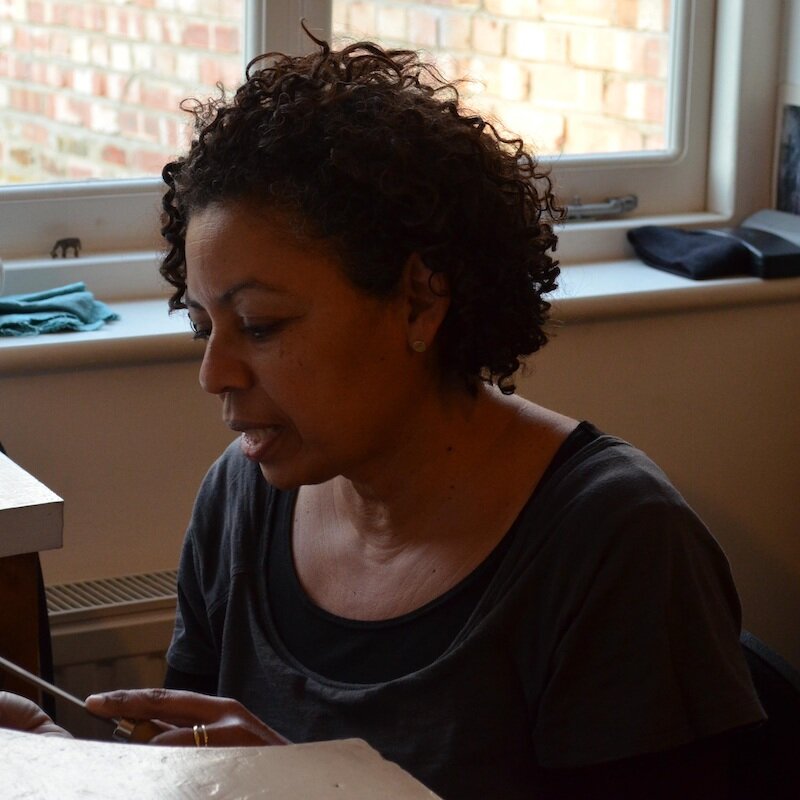
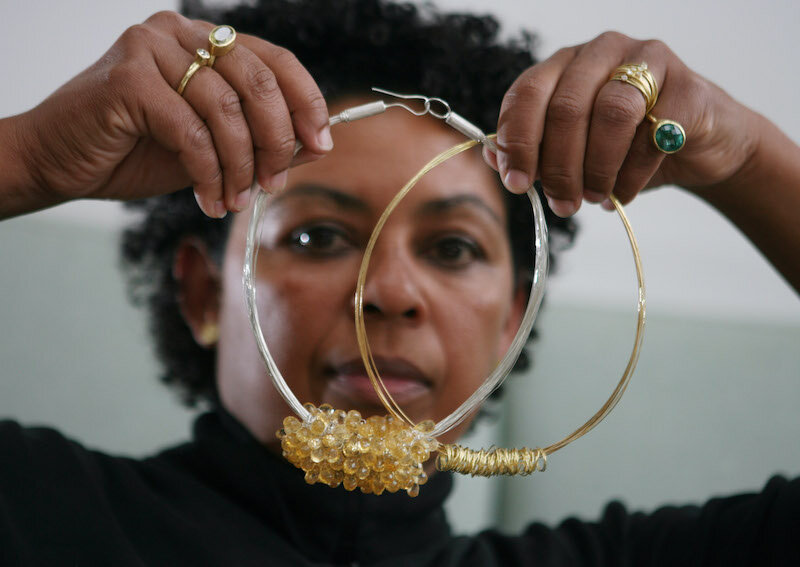 Jeweler Disa Allsopp, holds two of her 18 carat gold necklaces in her studio.Photographer: Suzanne Plunkett/Bloomberg News
Jeweler Disa Allsopp, holds two of her 18 carat gold necklaces in her studio.Photographer: Suzanne Plunkett/Bloomberg News
I sat down with Disa recently to talk about her work and history as a jeweler, including the varied places from which she draws inspiration...Meaghan: Disa, when I first saw your signature Spaghetti rings, I just loved the fluid nature of the design juxtaposed with the stillness of gold and silver. Can you describe how you go about designing your jewelry?Disa: I really enjoy marrying metals and working in high-karat gold and silver. I think for me, though, the most important part of my aesthetic is to make pieces that people actually want to wear. It sounds simple, but it's a challenge to make things that are not only beautiful and interesting but also comfortable. I like to design pieces that women can wear every day and choose to dress up for a special occasion. 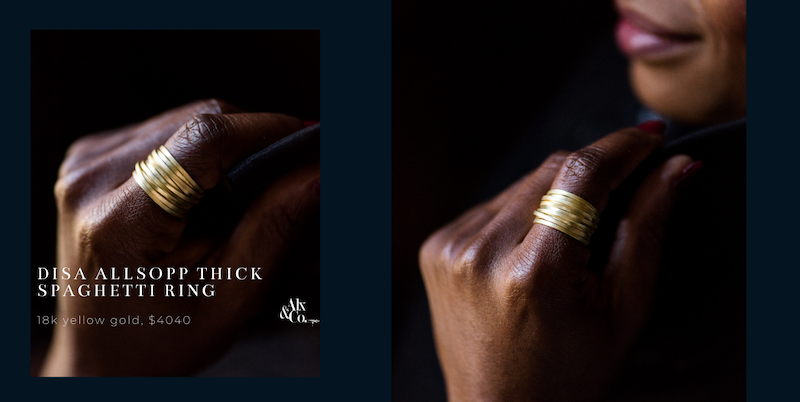 Meaghan: As an artist, from where do you draw inspiration for your collections?Disa: I draw inspiration from things around me, nature being the most obvious but also, importantly, food. I remember I was playing around at my bench with different shapes and thought back to a little sushi roll, kind of playing with the design to replicate this. I ended up making a pair of gold and black oxidized silver earrings that I call my sushi earrings, and a lot of my designs are the product of this type of playing. Those kinds of items that are daily wear pieces that are very special to me. Meaghan: What do you want wearers of your jewelry to feel while they are wearing a piece of yours?Disa: I want them to feel happy, comfortable… to wear the piece without knowing that they're wearing it so that it just sort of fits into their personality. I want people to just really enjoy wearing the piece of jewelry and have fun with it even if it's precious. I want people to wear my pieces with almost any outfit. I really love self-buyers, women who are confident and who know what they want and who will wear this piece of jewelry day in and day out.
Meaghan: As an artist, from where do you draw inspiration for your collections?Disa: I draw inspiration from things around me, nature being the most obvious but also, importantly, food. I remember I was playing around at my bench with different shapes and thought back to a little sushi roll, kind of playing with the design to replicate this. I ended up making a pair of gold and black oxidized silver earrings that I call my sushi earrings, and a lot of my designs are the product of this type of playing. Those kinds of items that are daily wear pieces that are very special to me. Meaghan: What do you want wearers of your jewelry to feel while they are wearing a piece of yours?Disa: I want them to feel happy, comfortable… to wear the piece without knowing that they're wearing it so that it just sort of fits into their personality. I want people to just really enjoy wearing the piece of jewelry and have fun with it even if it's precious. I want people to wear my pieces with almost any outfit. I really love self-buyers, women who are confident and who know what they want and who will wear this piece of jewelry day in and day out. 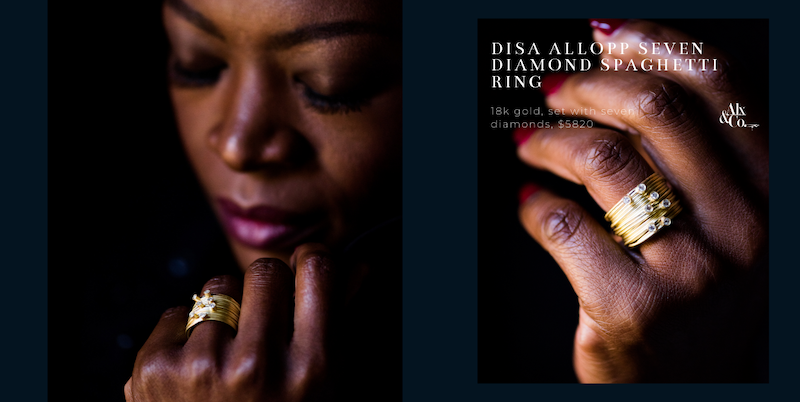 Meaghan: What brought you into jewelry making? Disa: Growing up, I traveled with my parents a lot. We would go all over the world, and I remember one time they took me to a little village called Taxco in Mexico. Taxco is a silversmithing community - everyone participates in the trade somehow - and it was so fascinating to watch them work with these pieces, shaping the metal. I have always loved making things - boxes, trinkets, drawing, and sketching, so the idea of creating jewelry felt very natural to me. It's funny, but I also love the tools - the tiny files, the little torches.So, I studied the craft in London and then went on to Edinburgh for further studies. At Edinburgh, we were taught to draw and sketch and to observe colors and shapes. I don't draw everything before fabricating, but when I work with clients, I always do. From there, I worked as an apprentice with a goldsmith in Chelsea called David Thomas Goldsmiths. I didn't work with him for a long time, but I learned a lot about casting, about producing things in quantity, producing repetitions of things, and polishing.I gained enough skill to set up my own studio back in Barbados where I had lots of casting equipment and did everything myself. Eventually, I decided to return to London to be with family and set up a workshop at a shared studio space with other makers. This was a very inspiring time for me, being surrounded by ceramicists and other creators in different mediums. I did a lot of fairs and shows and ended up getting a really nice order from Barney's in NY, which really helped my business grow. I eventually became big enough to where I needed my own studio space and hired other jewelers to work with me. It takes a lot of time to get to where I am now!
Meaghan: What brought you into jewelry making? Disa: Growing up, I traveled with my parents a lot. We would go all over the world, and I remember one time they took me to a little village called Taxco in Mexico. Taxco is a silversmithing community - everyone participates in the trade somehow - and it was so fascinating to watch them work with these pieces, shaping the metal. I have always loved making things - boxes, trinkets, drawing, and sketching, so the idea of creating jewelry felt very natural to me. It's funny, but I also love the tools - the tiny files, the little torches.So, I studied the craft in London and then went on to Edinburgh for further studies. At Edinburgh, we were taught to draw and sketch and to observe colors and shapes. I don't draw everything before fabricating, but when I work with clients, I always do. From there, I worked as an apprentice with a goldsmith in Chelsea called David Thomas Goldsmiths. I didn't work with him for a long time, but I learned a lot about casting, about producing things in quantity, producing repetitions of things, and polishing.I gained enough skill to set up my own studio back in Barbados where I had lots of casting equipment and did everything myself. Eventually, I decided to return to London to be with family and set up a workshop at a shared studio space with other makers. This was a very inspiring time for me, being surrounded by ceramicists and other creators in different mediums. I did a lot of fairs and shows and ended up getting a really nice order from Barney's in NY, which really helped my business grow. I eventually became big enough to where I needed my own studio space and hired other jewelers to work with me. It takes a lot of time to get to where I am now! 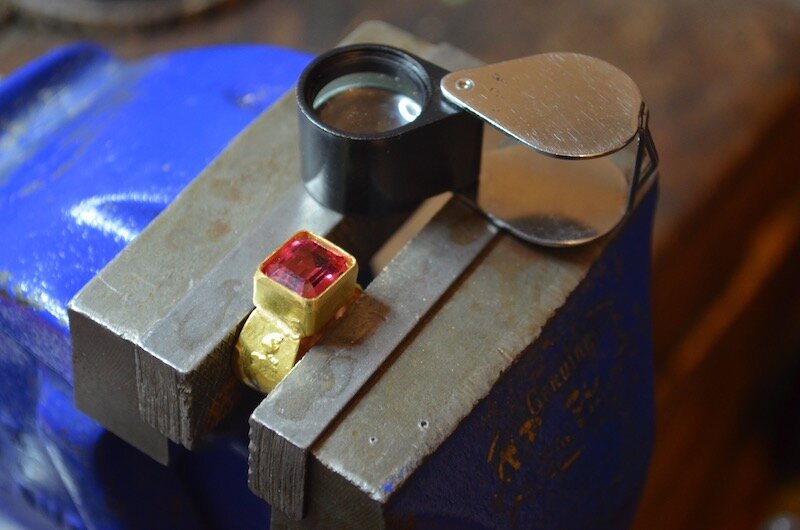 Meaghan: I love your Spaghetti Rings and the various forms they take. What inspired you to undertake this design?Disa: This started as a mistake, actually. I was at the bench and experimenting with the gold wire, playing with it, unraveling it, and it kind of took on that shape on its own and I really liked it. So, then I made it out of silver and liked that version, but then I tried again with a thicker wire and it was very uncomfortable. So I just continued to play with the form and let it evolve over a couple of months, creating different styles along the way. The trick is that the diamonds must be really top quality because you have to set them and then solder them on, so they have to be able to take the heat. Setting these with the larger stones is more complicated because the solder runs between the wires, but some people really like that. Everyone likes them a little different, so it has just evolved just by a combination of design and accident.I test-drive all of my pieces, so I tend to know which finger a piece is most comfortable on, how it wears. These also age so nicely and develop a beautiful patina as you wear them.
Meaghan: I love your Spaghetti Rings and the various forms they take. What inspired you to undertake this design?Disa: This started as a mistake, actually. I was at the bench and experimenting with the gold wire, playing with it, unraveling it, and it kind of took on that shape on its own and I really liked it. So, then I made it out of silver and liked that version, but then I tried again with a thicker wire and it was very uncomfortable. So I just continued to play with the form and let it evolve over a couple of months, creating different styles along the way. The trick is that the diamonds must be really top quality because you have to set them and then solder them on, so they have to be able to take the heat. Setting these with the larger stones is more complicated because the solder runs between the wires, but some people really like that. Everyone likes them a little different, so it has just evolved just by a combination of design and accident.I test-drive all of my pieces, so I tend to know which finger a piece is most comfortable on, how it wears. These also age so nicely and develop a beautiful patina as you wear them.  Meaghan: To you, what is the most important consideration when contemplating a "green" model in the jewelry industry?Disa: Oh, gosh… there is so much! I think it's to make sure that you are using sustainable and reusable materials, i.e., gold, silver, gemstones. It's often very difficult to go to a mine to see exactly what is going on with the collection of the gemstones, but you can build up a really good rapport with your gem dealer (it takes a while). I also go to Kenya each Christmas to purchase aquamarine, rhodolite garnet, and other gems from a small family-run business. Trust is really important so that you know the providence of a stone and where it comes from. Also, I take care to use safer products in my studio. When I pickle, I use the "safety pickle," which is allum based instead of nitric acid. It's important to me to not use the really strong chemicals that have been used by jewelers in the past.In general, though, with fine jewelry (especially bespoke fine jewelry like how we make it), it's the best way to keep your impact low. We are a small studio; everything is handmade, so it's very controlled - we reuse everything. There is no wastage or excess. I think if you have pieces that you love and really want to wear and can pass on to your children, that is sustainable to me.
Meaghan: To you, what is the most important consideration when contemplating a "green" model in the jewelry industry?Disa: Oh, gosh… there is so much! I think it's to make sure that you are using sustainable and reusable materials, i.e., gold, silver, gemstones. It's often very difficult to go to a mine to see exactly what is going on with the collection of the gemstones, but you can build up a really good rapport with your gem dealer (it takes a while). I also go to Kenya each Christmas to purchase aquamarine, rhodolite garnet, and other gems from a small family-run business. Trust is really important so that you know the providence of a stone and where it comes from. Also, I take care to use safer products in my studio. When I pickle, I use the "safety pickle," which is allum based instead of nitric acid. It's important to me to not use the really strong chemicals that have been used by jewelers in the past.In general, though, with fine jewelry (especially bespoke fine jewelry like how we make it), it's the best way to keep your impact low. We are a small studio; everything is handmade, so it's very controlled - we reuse everything. There is no wastage or excess. I think if you have pieces that you love and really want to wear and can pass on to your children, that is sustainable to me. 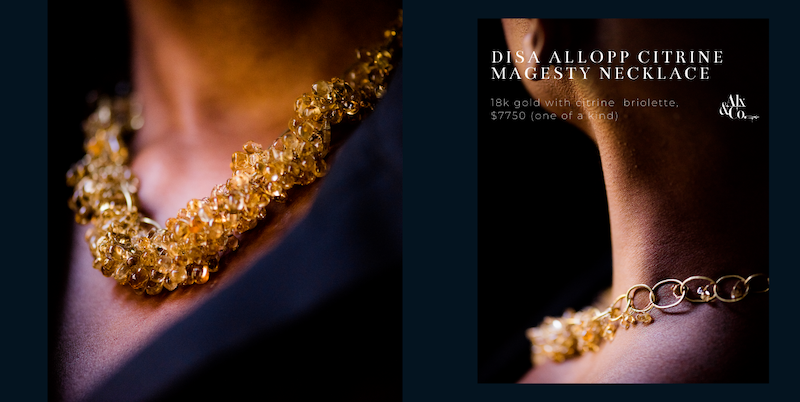 Meaghan: What do you wish clients understood better about jewelry in general?Disa: I really love when clients take the time to appreciate the tiny nuances in a piece. What makes a jeweler talented is their ability to work on such a small scale, so when a client takes a few minutes to examine a gemstone from underneath or to see the beauty of a ring's construction - just to look at it from another perspective - that's really rewarding for me. This is why visiting galleries and shops is so important for fine jewelry because you can take a piece out and learn all about it and get excited about it. I love sharing this experience with my clients. Thank you, Disa! We are so happy to have you featured in our showroom.
Meaghan: What do you wish clients understood better about jewelry in general?Disa: I really love when clients take the time to appreciate the tiny nuances in a piece. What makes a jeweler talented is their ability to work on such a small scale, so when a client takes a few minutes to examine a gemstone from underneath or to see the beauty of a ring's construction - just to look at it from another perspective - that's really rewarding for me. This is why visiting galleries and shops is so important for fine jewelry because you can take a piece out and learn all about it and get excited about it. I love sharing this experience with my clients. Thank you, Disa! We are so happy to have you featured in our showroom.